3D-Printed Quasi-Cylindrical Bragg Reflector to Boost the Gain and Directivity of cm- and mm-Wave Antennas
Abstract
:1. Introduction
2. Theoretical Framework
2.1. Layers Design for High Reflectivity on H-Plane
2.2. Gain Analysis for Triangular Aperture Optimization
3. Results and Discussion
4. Comparison with Previous Works
5. Conclusions
Author Contributions
Funding
Institutional Review Board Statement
Informed Consent Statement
Data Availability Statement
Conflicts of Interest
References
- Roh, W.; Seol, J.-Y.; Park, J.; Lee, B.; Lee, J.; Kim, Y.; Cho, J.; Cheun, K.; Aryanfar, F. Millimeter-Wave Beamforming as an Enabling Technology for 5G Cellular Communications: Theoretical Feasibility and Prototype Results. IEEE Commun. Mag. 2014, 52, 106–113. [Google Scholar] [CrossRef]
- Ahmed, S.S.; Genghammer, A.; Schiessl, A.; Schmidt, L.-P. Fully Electronic E-Band Personnel Imager of 2 m2 Aperture Based on a Multistatic Architecture. IEEE Trans. Microw. Theory Tech. 2013, 61, 651–657. [Google Scholar] [CrossRef]
- Jiang, Z.H.; Zhang, Y.; Xu, J.; Yu, Y.; Hong, W. Integrated Broadband Circularly Polarized Multibeam Antennas Using Berry-Phase Transmit-Arrays for Ka-Band Applications. IEEE Trans. Antennas Propag. 2020, 68, 859–872. [Google Scholar] [CrossRef]
- Kim, S.; Rida, A.; Lakafosis, V.; Nikolaou, S.; Tentzeris, M.M. 77-GHz mmWave Antenna Array on Liquid Crystal Polymer for Automotive Radar and RF Front-End Module. ETRI J. 2019, 41, 262–269. [Google Scholar] [CrossRef]
- Pozar, D.M. Microwave Engineering, 3rd ed.; Wiley: Hoboken, NJ, USA, 2005. [Google Scholar]
- Zhang, Y.; Mittra, R.; Hong, W. On the Synthesis of a Flat Lens Using a Wideband Low-Reflection Gradient-Index Metamaterial. J. Electromagn. Waves Appl. 2011, 25, 2178–2187. [Google Scholar] [CrossRef]
- Dhouibi, A.; Burokur, S.N.; Lustrac, A. Planar Metamaterial-Based Beam-Scanning Broadband Microwave Antenna. J. Appl. Phys. 2014, 115, 194901. [Google Scholar] [CrossRef] [Green Version]
- Pfeiffer, C.; Grbic, A. A Printed, Broadband Luneburg Lens Antenna. IEEE Trans. Antennas Propag. 2010, 58, 3055–3059. [Google Scholar] [CrossRef]
- Zhu, H.; Cheung, S.W.; Yuk, T.I. Enhancing Antenna Boresight Gain Using a Small Metasurface Lens. IEEE Antennas Propag. Mag. 2016, 58, 35–44. [Google Scholar] [CrossRef]
- Zhengbin, W.; Haofang, W.; Zhuangli, D.; Zhihang, W.; Yerong, Z.; Zhipeng, Z. Low-Profile Microwave Lens Antenna Based on Isotropic Huygen’s Metasurfaces. J. China Univ. Posts Telecomm. 2017, 24, 10–15. [Google Scholar] [CrossRef]
- Kim, J.H.; Ahn, C.-H.; Bang, J.-K. Antenna Gain Enhancement Using a Holey Superstrate. IEEE Trans. Antennas Propag. 2016, 64, 1164–1167. [Google Scholar] [CrossRef]
- Li, Q.L.; Cheung, S.W.; Wu, D.; Yuk, T.I. Microwave Lens Using Periodic Dielectric Sheets for Antenna-Gain Enhancement. IEEE Trans. Antennas Propag. 2017, 65, 2068–2073. [Google Scholar] [CrossRef]
- Zhang, Y.-X.; Jiao, Y.-C.; Liu, S.-B. 3D-Printed Comb-Mushroom-Like Dielectric Lens for Stable Gain Enhancement of Printed Log-Periodic Dipole Array. IEEE Antennas Wirel. Propag. Lett. 2018, 17, 2099–2103. [Google Scholar] [CrossRef]
- Belen, A.; Güneş, F.; Mahouti, P.; Palandöken, M. A novel design of high performance multilayered cylindrical dielectric lens antenna using 3D printing technology. Int. J. Microw. Comput. Eng. 2020, 30, e21988. [Google Scholar] [CrossRef]
- Yakushev, S.O.; Shulika, O.V.; Petrov, S.I.; Sukhoivanov, I.A. Chirp Compression with Single Chirped Mirrors and its Assembly. Microelect. J. 2008, 39, 690–695. [Google Scholar] [CrossRef]
- Iakushev, S.O.; Shulika, O.V.; Lysak, V.V.; Sukhoivanov, I.A. Air-Gap Silicon Nitride Chirped Mirror for Few-Cycle Pulse Compression. Optoelectronics and Advanced Materials. Rapid Commun. 2008, 2, 686–688. [Google Scholar]
- Busch, S.F.; Castro-Camus, E.; Beltran-Mejia, F.; Balzer, J.C.; Koch, M. 3D Printed Prisms with Tunable Dispersion for the THz Frequency Range. J. Infrared Millimeter Terahertz Waves 2018, 39, 553–560. [Google Scholar] [CrossRef]
- Vahdati, A.; Parandin, F. Antenna Patch Design Using a Photonic Crystal Substrate at a Frequency of 1.6 THz. Wirel. Pers. Commun. 2019, 109, 2213–2219. [Google Scholar] [CrossRef]
- Krupka, J.A.; Cwikla, A.; Mrozowski, M.; Clarke, R.N.; Tobar, M.E. High Q-factor Microwave Fabry-Perot Resonator With Distributed Bragg Reflectors. IEEE Trans. Ultrason. Ferroelectr. Freq. Control 2005, 52, 1443–1451. [Google Scholar] [CrossRef]
- Bale, S.J.; Deshpande, P.D.; Hough, M.; Porter, S.J.; Everard, J.K.A. High-Q Tuneable 10-GHz Bragg Resonator for Oscillator Applications. IEEE Trans. Ultrason. Ferroelectr. Freq. Control 2018, 65, 281–291. [Google Scholar] [CrossRef]
- Kaabal, A.; Ahyoud, S.; Asselman, A.; Faize, A. Design of High Gain Ultra Wide-Band Antenna for Wireless Communication Using EBG Structures. Europ. Sci. J. 2013, 9, 49–59. [Google Scholar]
- IEEE Xplore. Browse Standards: Get Program: Get 802(r) Standards. Available online: https://ieeexplore.ieee.org/browse/standards/get-program/page/series?id=68 (accessed on 30 October 2019).
- Liang, M.; Wu, J.; Yu, X.; Xin, H. 3D printing technology for RF and THz antennas. In Proceedings of the 2016 International Symposium on Antennas and Propagation (ISAP), Okinawa, Japan, 24–28 October 2016. [Google Scholar]
- Bjorgaard, J.; Hoyack, M.; Huber, E.; Mirzaee, M.; Chang, Y.-H.; Noghanian, S. Design and Fabrication of Antennas Using 3D Printing. Prog. Electromag. Res. C 2018, 84, 119–134. [Google Scholar] [CrossRef] [Green Version]
- Deffenbaugh, P.I.; Rumpf, R.C.; Church, K.H. Broadband Microwave Frequency Characterization of 3-D Printed Materials. IEEE Trans. Components Packag. Manuf. Technol. 2013, 3, 2147–2155. [Google Scholar] [CrossRef]
- Markos, P.; Soukoulis, C.M. Wave Propagation: From Electrons to Photonic Crystals and Left-Handed Materials; Princeton University Press: Princeton, NJ, USA, 2008. [Google Scholar]
- NatureWorks. Ingeo Biopolymer 3D850 Technical Data Sheet—3D Printing Monofilament—High Heat Grade. Available online: Https://www.natureworksllc.com/~/media/Files/NatureWorks/Technical-Documents/Technical-Data-Sheets/TechnicalDataSheet_4043D_films_pdf (accessed on 1 September 2021).
- Li, D. A Novel and Versatile Parabolic Reflector that Significantly Improves Wi-Fi Reception at Different Distances and Angles. J. Wirel. Netw. Commun. 2013, 3, 13–17. [Google Scholar]
- Chatterjee, A.; Parui, S.K. Performance enhancement of a dual-band monopole antenna by using a frequency-selective surface-based corner reflector. IEEE Trans. Antennas Propag. 2016, 64, 2165–2171. [Google Scholar] [CrossRef]
- Elzwawi, G.H.; Kesavan, A.; Alwahishi, R.; Denidni, T.A. A new corner-reflector antenna with tunable gain based on active frequency selective surfaces. IEEE Open J. Antennas Propag. 2020, 1, 88–94. [Google Scholar] [CrossRef]
- Chan, J.; Zheng, C.; Zhou, X. 3D printing your wireless coverage. In Proceedings of the 2nd International Workshop on Hot Topics in Wireless, Paris, France, 15 September 2015. [Google Scholar]
- Xiong, X.; Chan, J.; Yu, E.; Kumari, N.; Sani, A.A.; Zheng, C.; Zhou, X. Customizing indoor wireless coverage via 3D-fabricated reflectors. In Proceedings of the 4th ACM International Conference on Systems for Energy-Efficient Built Environments, Delft, The Netherlands, 8–9 November 2017; pp. 1–10. [Google Scholar]

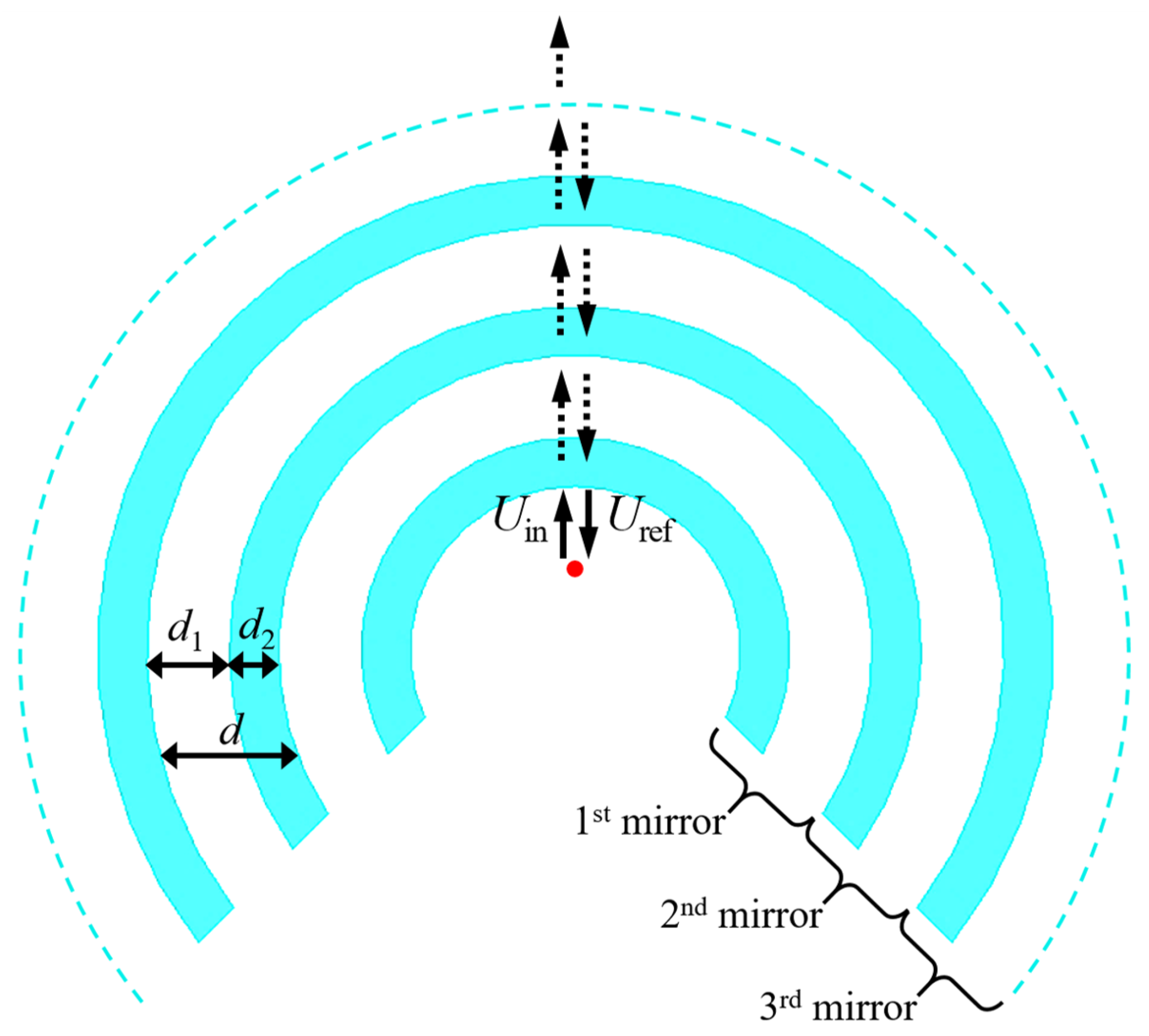
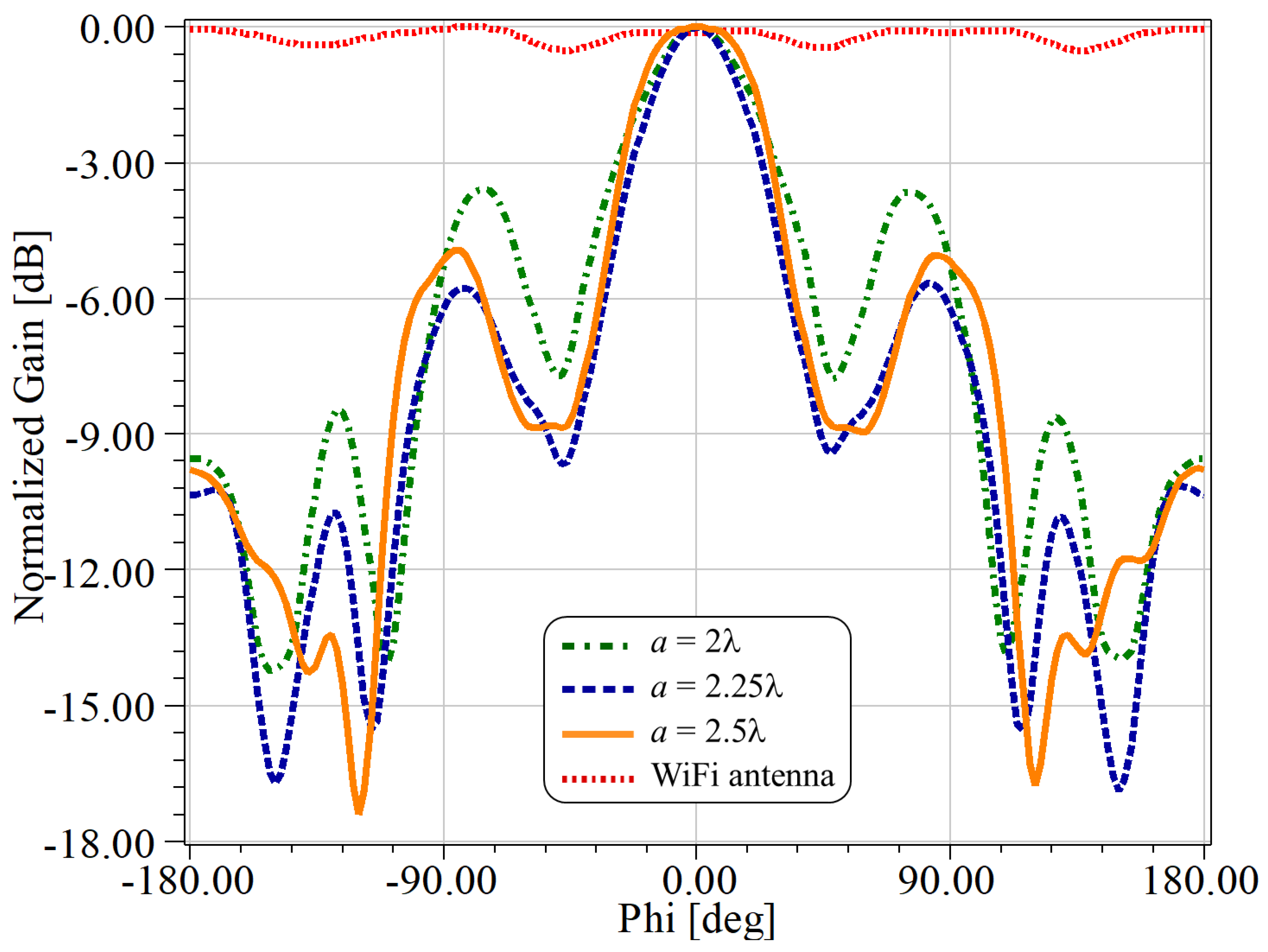
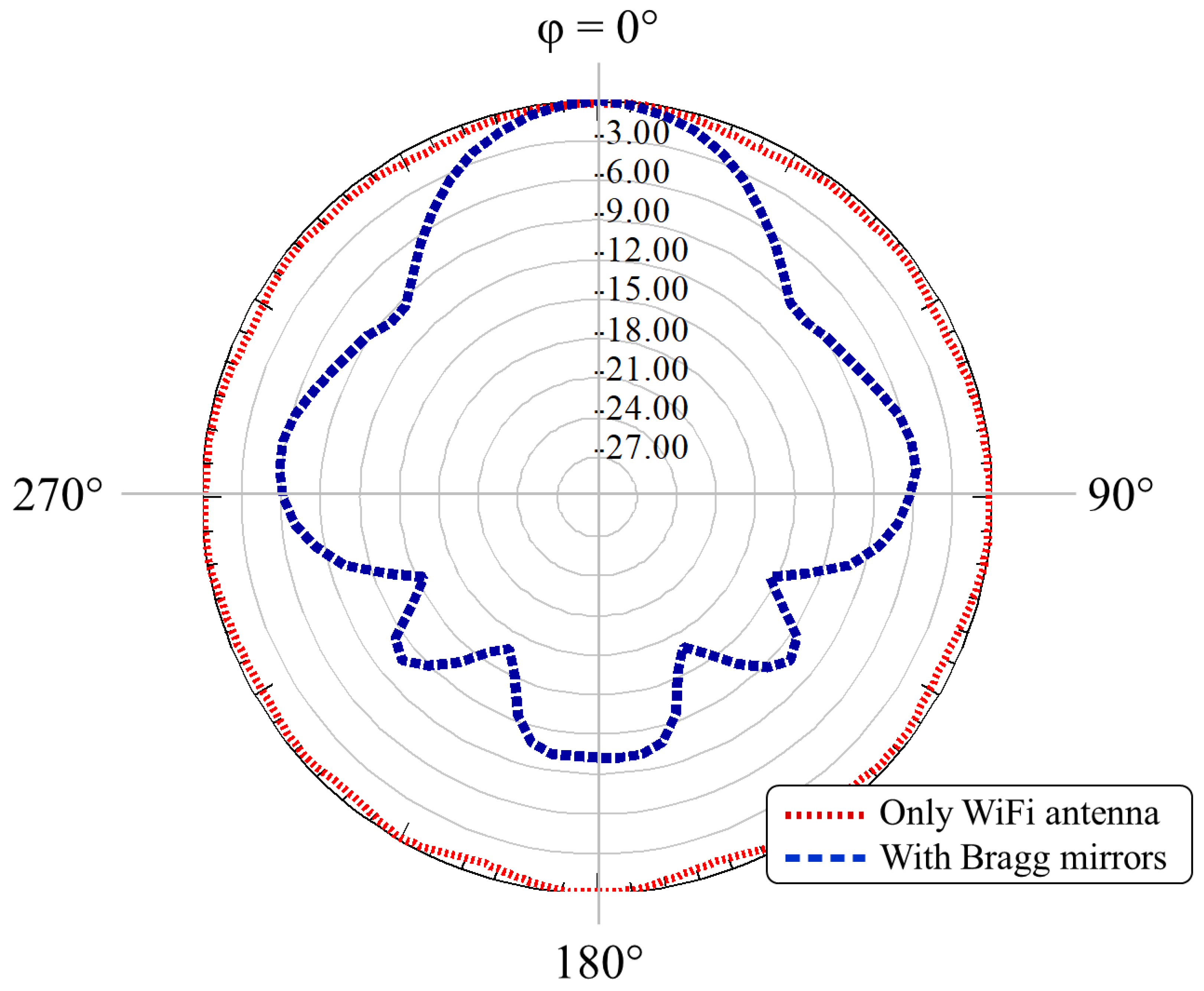

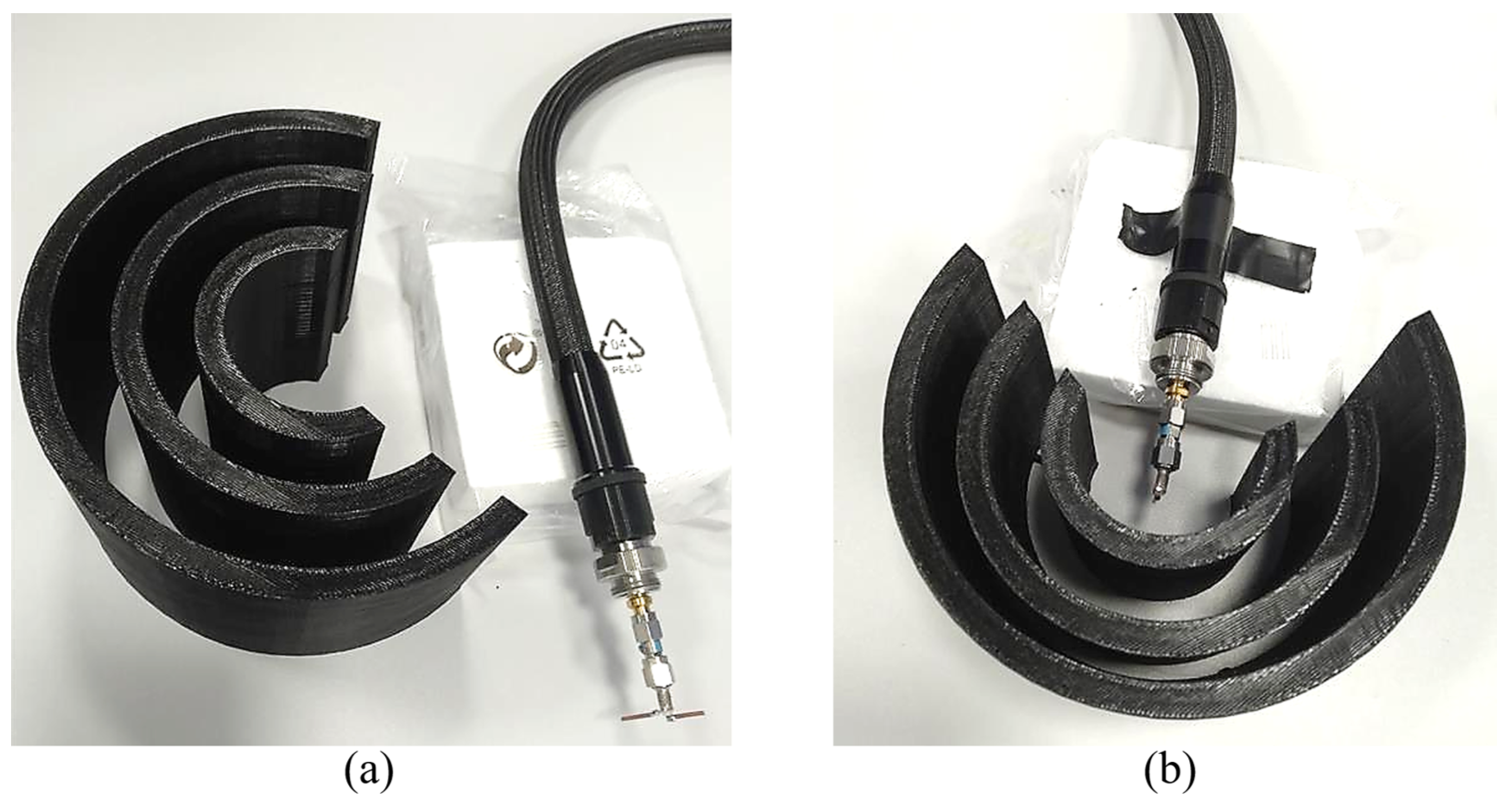
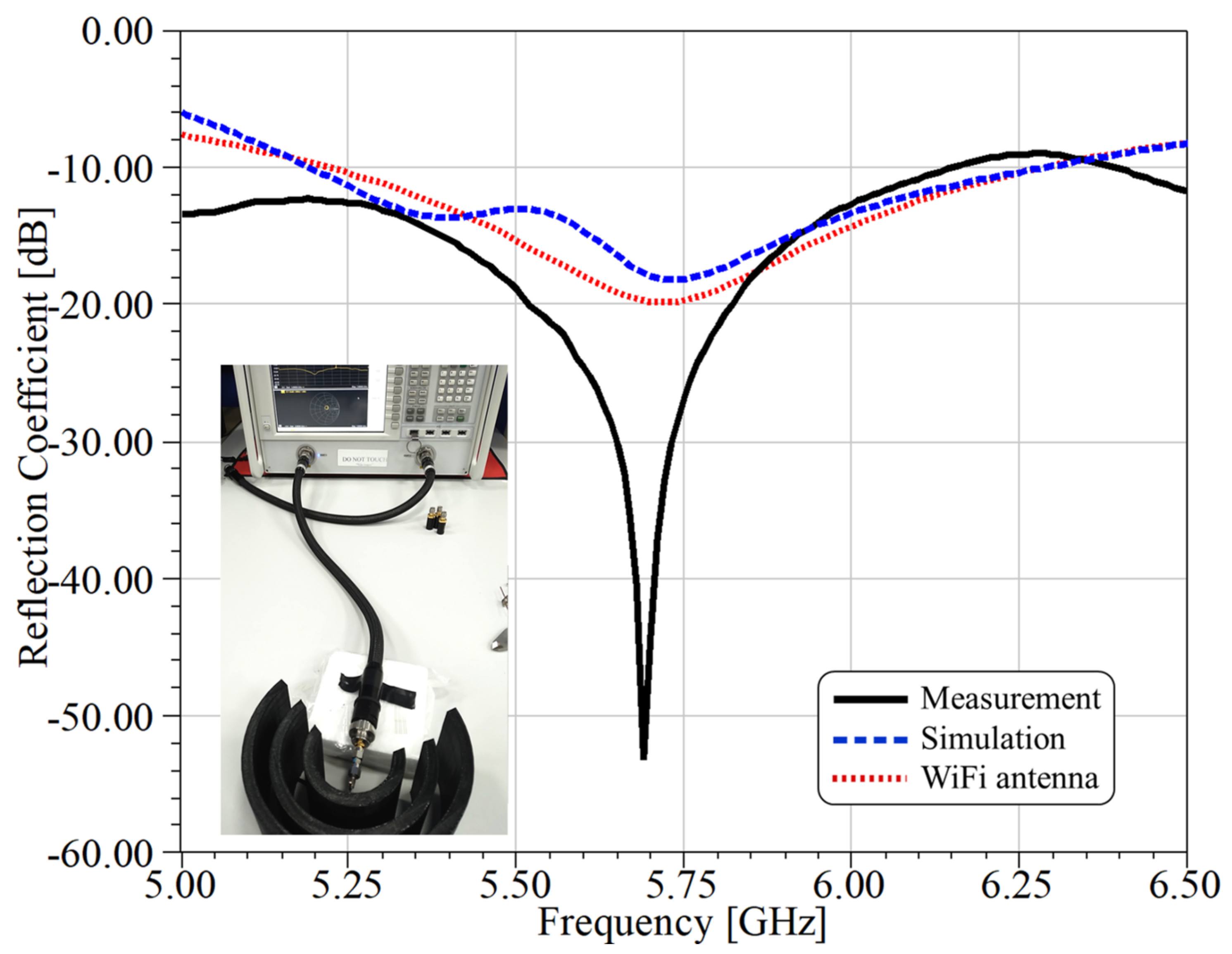
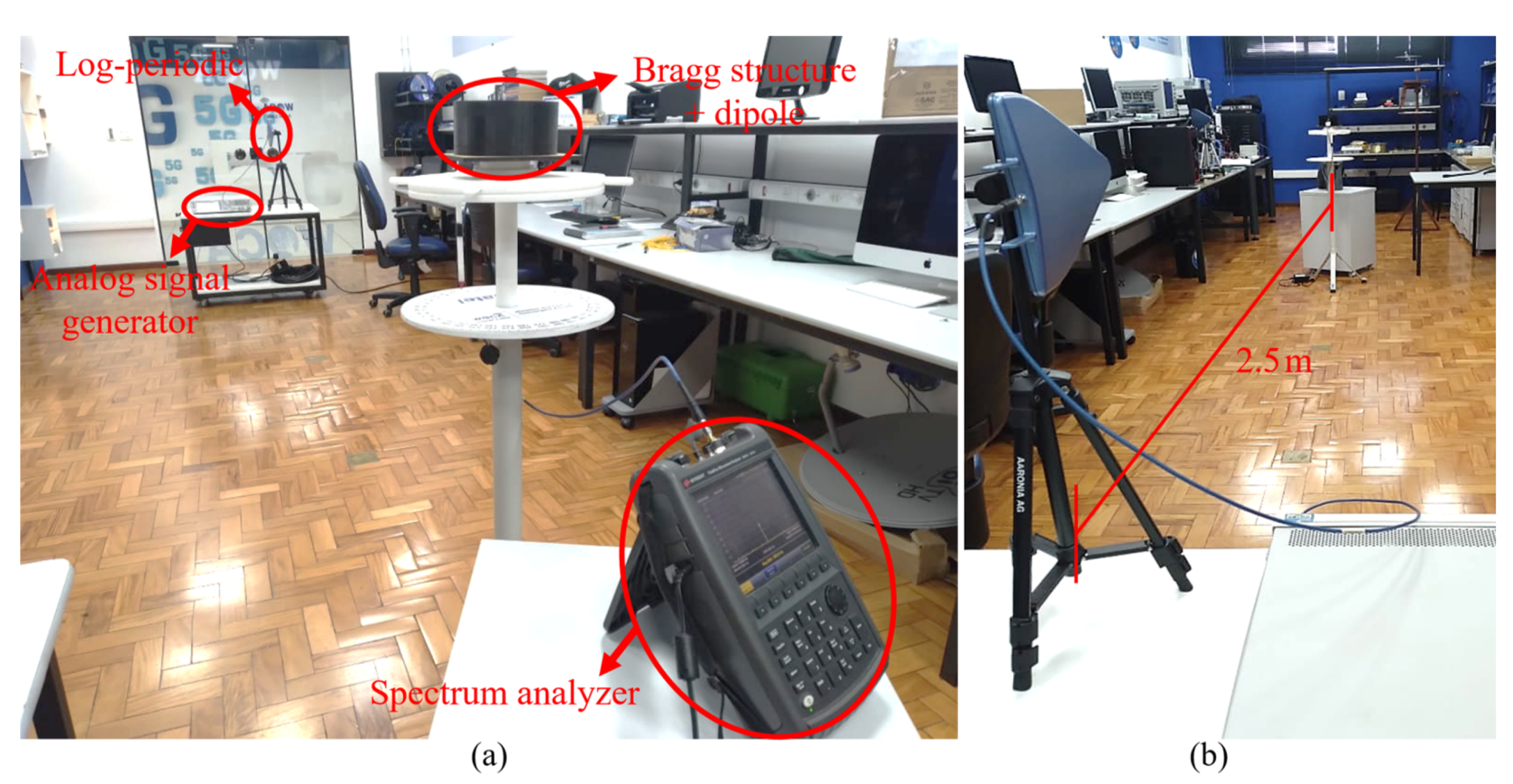
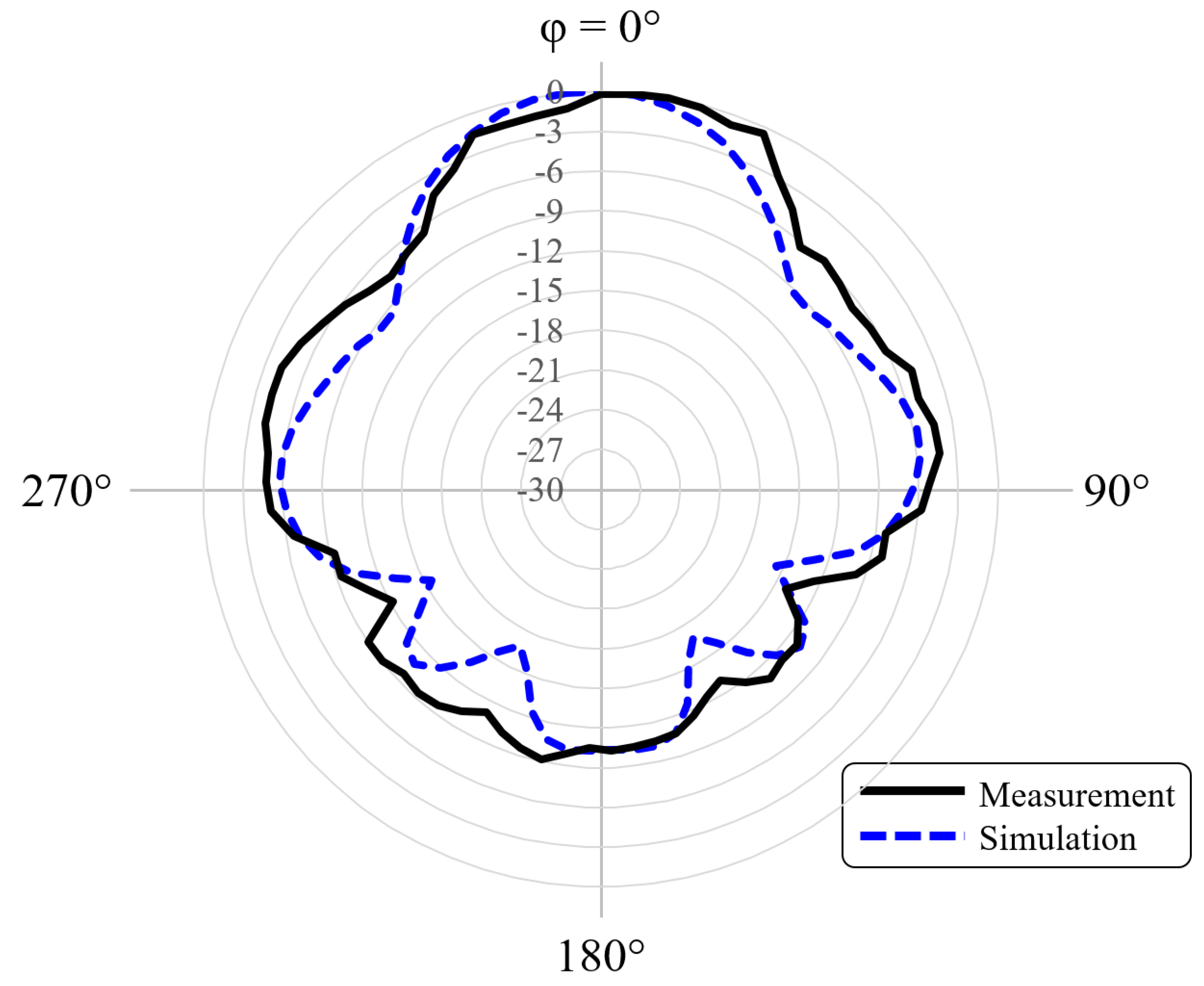
| Reference | Radiation | Manufacturing | |||
|---|---|---|---|---|---|
| WiFi Frequency | Gain Improvement | Size | Fabricated | Installation Local | |
| [28] | 2.4 GHz | 10 dB | Parabolic reflector with aluminum and wood | Close to antenna | |
| [29] | 5.5 GHz | 10 dB | (each array) | Corner Reflector with FSS | Close to antenna |
| [30] | 5.8 GHz | 9 dB | (each array) | Corner reflector with FSS | Close to antenna |
| [31] | 2.4 or 5 GHz | Different shapes | Dielectric 3D printed covered by aluminum | Close to antenna | |
| [32] | 2.4 GHz | 6 dB | Different shapes, according to the signal | Dielectric 3D printed covered by aluminum | Close to antenna |
| Proposed Bragg structure | 5 GHz | 9 dB | All dielectric 3D printed | Close to antenna | |
Publisher’s Note: MDPI stays neutral with regard to jurisdictional claims in published maps and institutional affiliations. |
© 2021 by the authors. Licensee MDPI, Basel, Switzerland. This article is an open access article distributed under the terms and conditions of the Creative Commons Attribution (CC BY) license (https://creativecommons.org/licenses/by/4.0/).
Share and Cite
Ribeiro, J.A.P.; Filgueiras, H.R.D.; Cerqueira Sodré Junior, A.; Beltrán-Mejía, F.; Mejía-Salazar, J.R. 3D-Printed Quasi-Cylindrical Bragg Reflector to Boost the Gain and Directivity of cm- and mm-Wave Antennas. Sensors 2021, 21, 8014. https://doi.org/10.3390/s21238014
Ribeiro JAP, Filgueiras HRD, Cerqueira Sodré Junior A, Beltrán-Mejía F, Mejía-Salazar JR. 3D-Printed Quasi-Cylindrical Bragg Reflector to Boost the Gain and Directivity of cm- and mm-Wave Antennas. Sensors. 2021; 21(23):8014. https://doi.org/10.3390/s21238014
Chicago/Turabian StyleRibeiro, Jéssica A. P., Hugo R. D. Filgueiras, Arismar Cerqueira Sodré Junior, Felipe Beltrán-Mejía, and Jorge Ricardo Mejía-Salazar. 2021. "3D-Printed Quasi-Cylindrical Bragg Reflector to Boost the Gain and Directivity of cm- and mm-Wave Antennas" Sensors 21, no. 23: 8014. https://doi.org/10.3390/s21238014







